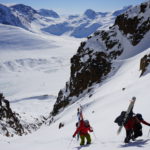Back when I started working as a climbing ranger in the Tetons, I would spend mornings in meditation on the west porch of the rescue cachewith retired ranger Tom Kimbrough and longtimeExum mountain guideGeorge Gardiner. The three of us would sitin silencethose early mornings and just occasionally share a word or two. We’dlook over the broad expanse of Lupine Meadows to the eastern rampart of Teewinot, and when the wind was right, we could hear the cascade of Broken Falls on her lower flank. It was common to have pronghorn, elk, or an occasional moose or black bear wander across the meadow. Sandhill cranes would call to one another from the privacy of Cottonwood Creek.
Tom had long been a mentor of mine both in the avalanche communityas well as the mountain rescue world. I didn’t know George as well, but we had a quiet, amiable relationship. He was twenty years my senior with a young son who would spend the summers with him, often working asrugratfor Jenny Lake Boating. JLB opened their arms wide to all the “orphaned” sons and daughters of the rangers and guides, and George’s son Michael was no different. George and I would often show in the mornings to the west porch of the rescue cache wearing the same striped wool beanie withatassel, the style typically favored by Nordic skiers. Ours were merlot in color with two horizontal stripes matched with that tassel. One morningGeorge brought over to the porch-I Am That, by Sri Nasargadatta Majaraj. I learned later that it was the book on interconnectednessand non-dualism. Georgewas fond of saying, “Same, same.”
One of my favorite memories was climbing the Petzoldt Ridge on the Grand with George. I had climbed it a few times before and was surprised that he had never been up the route. Along the way, we talked of how Exum guides often see people at their best while Jenny Lake climbing rangers often see people at their worst. There is a great deal of shared emotion that sometimes doesn’t make its way to the surface for years.
In this way, one of the most challenging parts of the climbing ranger job was to occasionallyconduct a body recovery. It is a rare season where no one perishes in the Teton range.
One of the mechanisms to shield ourselves from emotional pain was to look away from the face of the deceased and to create some sort of personal separation from her or him. Over time, I moved past this technique and instead slowdownand lookintently at the person, sometimes even talking quietly tothem. What I came to understand is thatby doing soIrealized thatI could just as easily be looking at myself as someone who could have made the same mistake. For me, this always brought about a certain compassion and humility.
In the aftermath of an accident, many people want to know what poor decisions had been made in order to fit the narrative that the people were “in over their heads”, or “taking too many risks”. All of this to cast judgment and separation to think, I would never have made that mistake. It’s an effective defense mechanism, but ultimately an illusion. Most often, I would attribute the accident to bad luck – rockfall, a slip on wet lichen, momentary inattention to the task at hand.
And so when fellow rangers Renny Jackson, Helen Motter, Marty Vidak and I were called in to find and extract George’s lifeless body in the Wall Street Gulley, our hearts were broken as we worked to bring George back to his family in Lupine Meadows. George had fallen while soloing the Direct Exum route on the Grand, a route he had done so many times, we all knew he could do it in his sleep.
The next day, three of us went up to climb the Direct Exum, a route we too had climbed many times before. On the broad second ledge, I looked over and saw a merlot-colored Nordic hat. My first thought was, ‘how did my hat…’. I reached for my head, and realized that as I was wearing mine. The hat on the ledge, of course, was George’s. Same, same.
Two winters later, I am briefly caught and carried in a very large avalanche in Yellowjacket Gulch in the Wasatch Range, a range where I work as an avalanche forecaster. I was spared, but lost my sunglasses and a Nordic beanie, merlot in color.
I Am That








